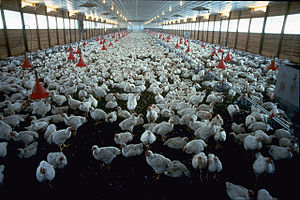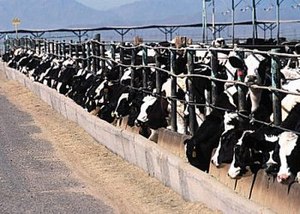 Example of self made recirculation Aquaculture system (Photo credit: Wikipedia)
Example of self made recirculation Aquaculture system (Photo credit: Wikipedia) Post Industrial Landscape (Photo credit: sharkbait)
Post Industrial Landscape (Photo credit: sharkbait) Cowshed near Denton. Industrial agriculture on Smithy Lane near Denton. (Photo credit: Wikipedia)
Cowshed near Denton. Industrial agriculture on Smithy Lane near Denton. (Photo credit: Wikipedia) A commercial broiler (meat) chicken operation (Photo credit: Wikipedia)
A commercial broiler (meat) chicken operation (Photo credit: Wikipedia) Description: Concentrated animal feeding operation. (Photo credit: Wikipedia)
Description: Concentrated animal feeding operation. (Photo credit: Wikipedia)2012 Hillman Prizes
Time to Stop Worrying and Learn to Love Industrial Agriculture?
We don't need to grow more food, we need to shift what we grow, where we grow it, and who grows it. As for the United States and Europe, "they would do well to grow less food and focus more on things like improving quality and building soil."
4 percent of the food consumed in the United States—and 11 percent of the fruits and vegetables—is organic. How much of the USDA's research budget is devoted to organic research, including projects like developing proper organic seed lines? Less than 1 percent, the National Sustainable Agriculture Coalition's Ferd Hoefner recently told me. The other 99 percent goes to industrial ag—yet another de facto public subsidy to the agrichemical industry.
- Biodynamics: Secrets of the Soil (Financial Times, 05/05)
- GMO 'Right to Know' Campaign in CT Fails - Lawsuit Threatened(Digital Journal, 05/05)
- Widespread GMO Contamination: Did Monsanto Plant GMOs Before USDA Approval?(Global Research, 05/04)
- Groups Push for Vote on GMO Food Labels(Reuters, 05/02)
- Human Genes Engineered into Experimental GMO Rice Being Grown in Canada(Natural News, 05/02)
- By Growing Food, Occupy the Farm Helps a Movement Grow Up(Grist, 05/01)
- Saving the Sacred Seeds(Non-GMO Report, 05/01)
- Inner gardening(Cityfood Growers, 05/01)
- Farm-Connected CSAs Should Offer More Than Just 'Veggie Subscriptions' (Grist, 04/30)
- Genetically Modifed Crops' Results Raise Concerns (San Francisco Chronicle, 04/30)
- UK: The Biodynamics Behind Some Great-Tasting Wines (Hull Daily Mail, 04/28)
I’m thinking of a single building to act as a mini city.
Alternative Uses for Our Military Budget
Ever wonder what we could do with all the money we spend on offense?
( Waste being offensive )
Chen Guangcheng a Case Study for America's Future
As many people already know, China implements a one child policy. However what was relatively unknown until Chen's work, is that this policy is in some cases brutally enforced, even leading to forced abortions and sterilization.
Of course, nothing like that could ever happen in America right? I mean there's no way the government would force people to do something like that, right? Wrong. We've gotten close to such situations before and we're on that path again.
Of course, nothing like that could ever happen in America right? I mean there's no way the government would force people to do something like that, right? Wrong. We've gotten close to such situations before and we're on that path again.
After all, did anyone ever think that America could go as far as imprisoning an entire group of American citizens simply because of their country of origin? Or in modern times the idea that the government can ignore privacy rights and rights to free speech on the internet.
Media and Police
Whatever the view of the case involving George Zimmerman and Trayvon Martin, it is pretty obvious that media outlets have put a spin on the case in order to increase ratings. "Member of neighborhood watch kills innocent man thinking he's a thief" does not sell as much as "racist white man shoots innocent black high school student".
Debt Collectors in the E.R. and Delivery Room: Is Profit-Driven Medicine at a Breakpoint?
Read more: http://healthland.time.com/2012/04/25/debt-collectors-in-the-e-r-and-delivery-room-is-profit-driven-medicine-at-a-breakpoint/#ixzz1uFSo4WBW
Read more: http://healthland.time.com/2012/04/25/debt-collectors-in-the-e-r-and-delivery-room-is-profit-driven-medicine-at-a-breakpoint/#ixzz1uFSo4WBW
The expansion of private-security contractors in Iraq and Afghanistan is well known. But armed security personnel account for only about sixteen per cent of the over-all contracting force. The vast majority—more than sixty per cent of the total in Iraq—aren’t hired guns but hired hands. These workers, primarily from South Asia and Africa, often live in barbed-wire compounds on U.S. bases, eat at meagre chow halls, and host dance parties featuring Nepalese romance ballads and Ugandan church songs. A large number are employed by fly-by-night subcontractors who are financed by the American taxpayer but who often operate outside the law.
The wars’ foreign workers are known, in military parlance, as “third-country nationals,” or T.C.N.s. Many of them recount having been robbed of wages, injured without compensation, subjected to sexual assault, and held in conditions resembling indentured servitude by their subcontractor bosses. Previously unreleased contractor memos, hundreds of interviews, and government documents I obtained during a yearlong investigation confirm many of these claims and reveal other grounds for concern. Widespread mistreatment even led to a series of food riots in Pentagon subcontractor camps, some involving more than a thousand workers.
Read more http://www.newyorker.com/reporting/2011/06/06/110606fa_fact_stillman#ixzz1uFLC1ot0
Located at an oil refinery on Norway's west coast, the Technology Centre Mongstad aims to test French and Norwegian methods of capturing carbon dioxide emissions and burying them underground to prevent them from escaping into the atmosphere.
"We need to find a way to reconcile the need for energy and the need for emission reductions," said Prime Minister Jens Stoltenberg as he inaugurated the site.
"Carbon-capture technology is a key," he said, adding: "This technology may deliver up to 20 percent of the emission reductions needed by 2050."
Built at an estimated cost of 5.9 billion Norwegian krone (780 million euros/$1 billion) mainly with state funds, the Mongstad centre is "the world's largest and most advanced laboratory for testing carbon-capture technologies", Stoltenberg said.
The centre is three-quarters owned by the state firm Gassnova, followed by a 20 percent stake held by Norway's Statoil, with the Anglo-Dutch Shell and South Africa's Sasol holding the remaining stakes.
It is testing technologies of the French company Alstom and those of Norway's Aker Solutions.
( Lovely. Taking oxygen out of the atmosphere is considered a remarkable technical achievement ( it is co2 after all . Smart might be another question entirely )
CALGARY - A project to capture carbon dioxide emissions from an Alberta coal plant …Full Story »


























No comments:
Post a Comment